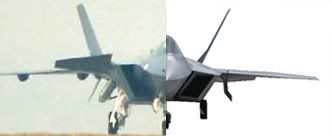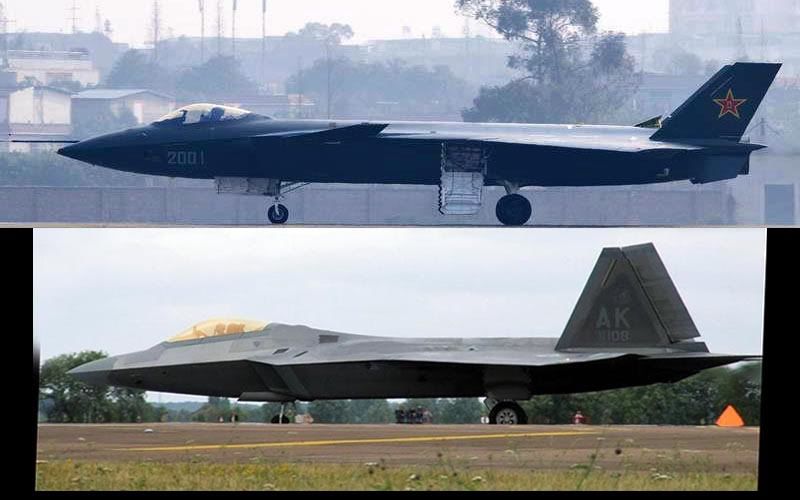FarkTypeSoldier
Junior Member
Wow... Good and justify comments. All participants given their fair judgements.

Left-half of picture is China's J-20. Right half is U.S. F-22.
(Note the J-20 air-inlet has been better integrated into the fuselage than the F-22's gap between the air-inlet and fuselage.)
I have two observations. Firstly, as shown in the spliced-photo above, I believe that I have been proven correct that the J-20 matches the F-22's frontal profile in stealth design.

Above: Picture of sleek J-20 with small tailfins.
Below: Picture of sleek F-22 with large tailfins.
Secondly, the F-22 may have tailfins that are significantly larger than the J-20. Given the increased surface area to reflect radar, this raises the possibility that the F-22 may have a higher side-profile stealth signature than the J-20 and is more vulnerable to bi-static or multistatic radar systems.
Note: Thank you to HouShanghai for the photographs.
I think WS-10 series is not China's only indigenous engine. CAC doesn't like SAC or Shenyang Liming, so they got their own Chengdu factory to reverse-engineer AL-31F while extending its service life. Now China makes its own AL-31F variants, which are used in J-10's, J-10B prototype and J-20 prototype. That's why China's never buys AL-31F from Russia anymore, but seems to have an unlimited supply of them.The engine has two layer of pedals. The internal ones seals the nozzle, controls the size of the airflow. It is a critical component of the engine.
The external ones are for aerodynamics purpose only. It hides the control elements for the internal pedals. We often see F-15 photos with the external pedals removed.
So it is quite easy and safe to create your own external pedals. It won't change the engine performance.
I really wish the J-20 flew with Chinese engines. However, let me repeat - the black and silver nozzles are the same engine (same length, same diameter). The color and shape of the external pedals don't mean a thing.
Between AL-31F and WS-10, I would have to say they are AL-31F due to the pedal count.
However, we cannot remove the slight possibility that they are a different variant of WS-10 - either a modified WS-10A, specifically for J-20, or WS-10G.
Come on guys ... just help me out a bit !... maybe I missed a bit.
All I remember is a report that CAC managed to extend the service life ... that doesn't mean that they developed and produce an indigenous AL-31F.
I'm sure - with all the Russian complaints about the Flanker copies - there would have been an outcry in the Russian public ... so far I didn't read anything.
Sorry, but can anyone show me that article, report or source PLAESE !??
Deino
We are just speculating Deino, there is no proof. I think we are all desperately trying to explain why AL-31s are being used on China's latest and greatest. So far no answer seems to suffice.
According to the Jane's article, they already extended the service life of AL-31F by a large factor. Presumably this means they replaced key components like the turbine blades. It seems they know this engine in and out so well that it's not difficult to produce a replica or improved variant.Come on guys ... just help me out a bit !... maybe I missed a bit.
All I remember is a report that CAC managed to extend the service life ... that doesn't mean that they developed and produce an indigenous AL-31F.
I'm sure - with all the Russian complaints about the Flanker copies - there would have been an outcry in the Russian public ... so far I didn't read anything.
Sorry, but can anyone show me that article, report or source PLAESE !??
Deino
